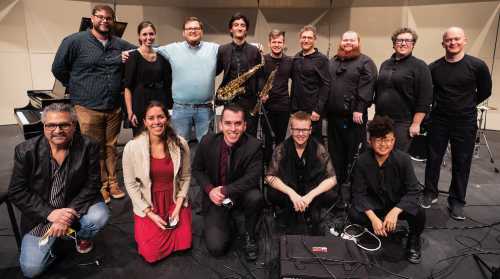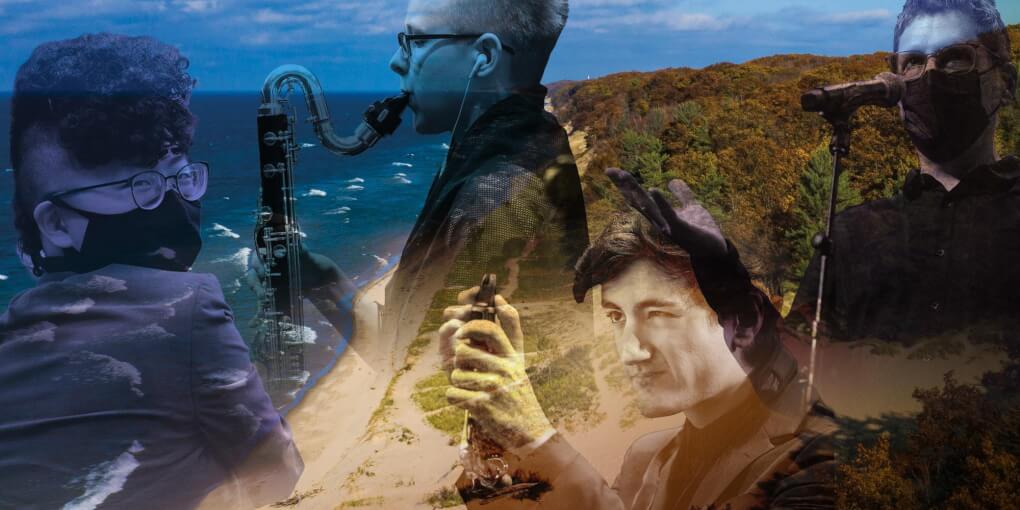
New Music Ensemble students and commissioned composers are pictured with Bill Ryan (sixth from left, top row). Top row, left to right: Nathan Hudson, Lydia Seaver, Logan Rutledge, Linus Guerra, Noah Braley, Ryan, Christian Glascock, Olivia Kieffer, Elijah Smith; bottom row, left to right: Marc Melllits, Elena Specht, Tony Manfredonia, Gracie Barrett and Stephanie Bueche.
Bill Ryan, an avid outdoor enthusiast, got to thinking several years ago: Is there a way to combine two of his passions — nature and the GVSU New Music Ensemble that he leads?
From that initial thought sprung a musical tour de force that has seen the acclaimed group crisscross the country to play specially commissioned pieces reflecting the natural beauty of national parks.
The tours, which will number five this summer, have earned four coveted National Endowment for the Arts grants. They started to take shape after Ryan put his idea into action by sending emails detailing his proposal to national parks officials.
The response was initially tepid, Ryan said, but he was undeterred. He patiently persisted, driven by the same tenacity to expand the reach of the ensemble that he has possessed since he founded the group.
Ryan has long sought to leverage what he and others describe as the essence of new music — a reflection of contemporary moments and times — by exposing the ensemble members to unique situations and opportunities.
Besides the national parks tours, the ensemble also performed specially commissioned pieces to capture the majesty of Lake Michigan. In March, the ensemble helped mark the 10th anniversary of the annual Art Gallery Music Composition Competition — in which student composers also taught by Ryan create 60-second works in response to artwork in the Louis Armstrong Theatre Lobby — by performing works from current student composers as well as selections from former prizewinners who competed for alumni prizes.
This creativity and Ryan’s passionate advocacy promoting the ensemble’s work has helped attract more interest in the group, which has received international recognition and has carved out a niche in the classical music scene.
That all starts with the music, and what makes Ryan most proud is when the ensemble is lauded for its professional-level quality.
“The fact that we’re covered by some of these publications floors me,” Ryan said. “These are mainstream professional publications that have an interest in what we’re doing. The students leave here and they have press quotes from NPR and the New York Times and others on their resumes — as undergrads.”


An ensemble is born, buzz soon follows
Ryan’s earliest promotional efforts for the New Music Ensemble involved designing posters to intrigue people about what he was planning to create.
He arrived at Grand Valley in 2005 to teach composition with the added duty of starting a contemporary music ensemble. After taking a semester to get organized, Ryan led the New Music Ensemble’s first performance in spring 2006.
Just a year later, a seminal performance helped put the ensemble on the musical radar and, “We haven’t looked back,” Ryan said. It was also a time when Ryan took an unexpected chance to put their music into the world.
Ryan had chosen a difficult, specialized piece by renowned composer Steve Reich for the ensemble to study and learn to play. His main goal was to get through the concert, not record an album.
But the ensemble played the piece remarkably well. Ryan sent a recording of the concert to a record label to gauge interest in an album, which there was. The ensemble then recorded Steve Reich’s “Music for 18 Musicians” over three days at St. Cecilia Music Center in Grand Rapids.
“People loved it,” Ryan said.
He added: “I would have been laughed at if I initially said, ‘Let’s record an album.’ But I wouldn’t have pursued it if the group wasn’t sounding professional.”
The response from the music world was resounding approval. The album spent 11 weeks on the Billboard charts and was named one of the top five classical recordings of the decade by WNYC.
The New Yorker said, “Michigan musicians play with glistening precision.” The San Francisco Chronicle referred to it as the “surprise new-music hit of 2007.”
Why did that album strike such a chord? Ryan suspects part of the fascination was music aficionados on the coasts discovering a performance from undergraduate students at a Midwestern school.
But first and foremost, he said, the quality of the work had to shine. At the time, only a handful of professional groups had tackled the demanding music that the GVSU ensemble performed, he said. And those who know music thought the undergraduates from Grand Valley were on par with any professional group.
Once on that radar, the buzz has indeed continued through subsequent albums and special performances, including the ongoing tours of national parks that have garnered wide interest and accolades. An album in 2017, “RETURN,” which included 15 works composed by Ryan’s former students, earned praise from NPR’s Tom Huizenga, who said, “Calming, alluring and sophisticated all at once, ‘RETURN’ marks a high point for Ryan, his ensemble and former students.”

The New Music Ensemble performs in 2018 at Olympic National Park in Washington. To see more photos of the New Music Ensemble on their past tours visit newmusicensemble.org .
‘You’re going to play really hard music and play it really well’
The GVSU New Music Ensemble has a core group of players on six instruments: flute, clarinet, bass clarinet, saxophone, piano and percussion. A seventh student works as a sound engineer.
The goal is to expose students to contemporary music “that’s alive and created in the last 25 years. For the most part, the focus is on right now,” he said. This approach complements what students are learning in other music classes, with composers and pieces that are often hundreds of years old.
That lineage runs through contemporary classical music, Ryan said, with the genre running the gamut from paying homage to these long-ago composers to creating pieces that are experimental, such as going to auto junkyards to use brake drums for percussion. Modern classical composers also borrow elements from folk, pop, jazz and other music genres and, routinely, incorporate electronics and other aspects of technology.
“It is exciting to me and to our players that our programs can be very diverse, and they are learning new performance techniques from composition to composition often because it’s so wide open,” Ryan said.
The wide-open nature attracted Ashley Stanley ‘14 to Grand Valley. Stanley, a flute player, came across the ensemble’s music on YouTube while considering whether to attend GVSU.
“I thought, ‘This is the coolest thing I have seen someone do with a classical instrument,” Stanley said. “The first thing I did was knock on Bill Ryan’s door and ask if he needed a flute player.”
Stanley said new music has an equalizing quality because it’s accessible to all listeners, no matter their level of musical knowledge.
“When I go to a new music concert, the focus is much more on the artistry and a lot less on the historical knowledge,” Stanley said.
And performing in the New Music Ensemble meant exhibiting top-notch artistry, Stanley said. “You’re going to play really hard music and play it really well. That’s just Bill’s expectation.”
Gracie Barrett, who is majoring in music education with a concentration on clarinet performance, played clarinet for two years in the ensemble and most recently switched to bass clarinet.
“One of my favorite parts of new music is how culturally relevant it is and how in the moment you get to be in the music,” Barrett said.
Barrett said the quality level from an undergraduate ensemble is remarkable, and credited Ryan with his determination to elevate the group’s work in the music world, leading to wide acclaim.
Another advantage of working with new music is the opportunity to collaborate with composers and get insight on their thinking, Barrett said.
That is a crucial part of the national parks tours.
Natural beauty, beautiful music
Stanley was part of the first tour of national parks, and quickly overcame some initial skepticism to come to see that time as a “life-changing experience.”
Barrett described participating in the latest tour, which took the ensemble to national parks in the eastern and middle parts of the U.S., the same way, saying it was a “spiritual experience.” “It was kind of life changing to see these different landscapes and then perform brand new music in these landscapes that are so beautiful,” Barrett said.
So far, the ensemble has visited 20 national parks, with plans to visit five more in summer of 2022, Ryan said.
Ryan commissions composers to create music that reflects a feature of a national park that inspires the artist. Ensemble players work with the composer in rehearsals, then travel to the parks to perform the specially commissioned piece for that location as well as others.
Their travels have taken them from Yellowstone National Park to Acadia National Park in Maine to Indiana Dunes National Park. Ryan has regularly received National Endowment for the Arts grants to help fund the journeys.
And while Ryan hadn’t set out to create an album from the performances, he was inspired to do so when considering the work they had received from composers. That led to 2020’s “Dawn Chorus,” an 11-track album that included all of the pieces from the 2016 tour as well as selections from the 2014 performances. It was the ensemble’s fifth commercial recording.
This melding of the outdoors and the music of the ensemble that Ryan envisioned those many years ago has proven to be a success that has continued to keep the New Music Ensemble on the musical radar.
But even more importantly, Ryan said, these tours have continually inspired both him and the talented, revolving group of undergraduates who play new music at a professional level.
“We’re performing the compositions in the locations and with the backdrops that inspired them. It can be a very emotional experience for us,” Ryan said.
“I don’t know who has the better experience, the audience or us.”







